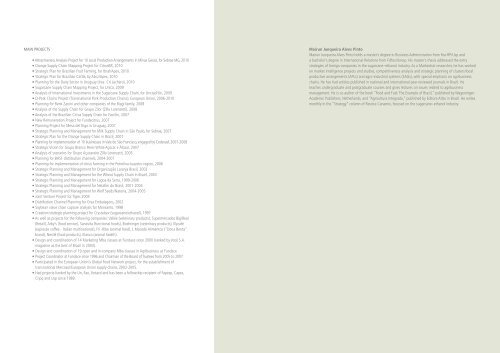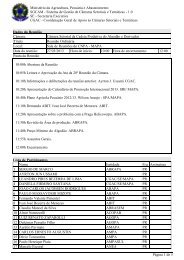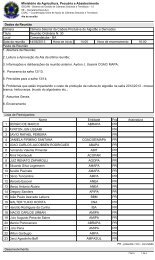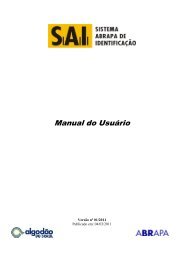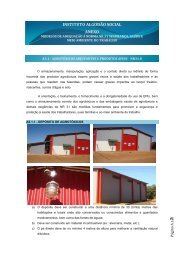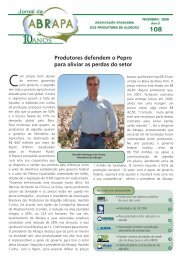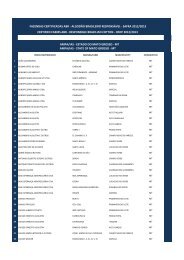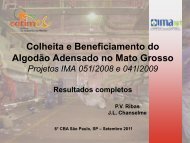The Brazilian Cotton Chain - Abrapa
The Brazilian Cotton Chain - Abrapa
The Brazilian Cotton Chain - Abrapa
You also want an ePaper? Increase the reach of your titles
YUMPU automatically turns print PDFs into web optimized ePapers that Google loves.
BILLIONS OF REAIS (R$)<br />
2.5<br />
2.0<br />
1.5<br />
1.0<br />
0.5<br />
0<br />
ESTIMATE OF THE EFFECT OF THE REAL EXCHANGE RATE ON EXPORTS<br />
R$ 0.02<br />
R$ 0.65<br />
2006<br />
R$ 0.16<br />
R$ 0.99<br />
2007<br />
R$ 1.28<br />
2008<br />
REVENUE R$ NOMINAL EXCHANGE RATE<br />
2009<br />
ADDITIONAL REVENUE R$ REAL EXCHANGE RATE<br />
Graph 2.9 - Estimates of export revenue of the cotton sector: nominal exchange rate and real exchange rate - 2006 to 2010.<br />
Source: Compiled by Markestrat based on data from the Central Bank of Brazil<br />
If, on the one hand, the weak dollar has<br />
harmed revenue in R$ of cotton growers,<br />
on the other hand it has benefited<br />
importers. And despite the unfavorable<br />
exchange rate for exporters, the cotton<br />
sector remained firm in exports of cotton<br />
fiber as a global supplier. Other sectors,<br />
R$ 0.34<br />
R$ 0.37<br />
R$ 1.64<br />
R$ 0.53<br />
R$ 1.20<br />
2010<br />
however, have exhibited greater difficulty<br />
to resist pressure from the increased value<br />
of the <strong>Brazilian</strong> Real (R$), as is the case of<br />
the textile industry. In fact, the exchange<br />
rate today is a major constraint in <strong>Brazilian</strong><br />
production chains.<br />
THE CONDITIONS OF LOGISTICS INFRASTRUCTURE INCREASE THE COST OF<br />
PRODUCTION AND DISTRIBUTION OF BRAZILIAN COTTON, REDUCING ITS<br />
COMPETITIVENESS AND POSSIBLY EVEN HARMING ITS IMAGE ABROAD.<br />
<strong>Brazilian</strong> exports face many problems related<br />
to the logistics of products, which affects<br />
the profitability of producers, cooperatives<br />
and trading companies. Among the most<br />
prominent difficulties are the poor conditions<br />
of roadways and the low capacity of<br />
alternative modes of transportation such as<br />
railways and inland waterways.<br />
In the case of cotton, for which most of the<br />
production exported comes from states in<br />
the Center-West and western Bahia, the<br />
situation is further complicated due to long<br />
distances. For example, the distance between<br />
Rondonópolis, Mato Grosso and the Port<br />
of Santos is over 1,400 kilometers. It is<br />
noteworthy that such distances make not only<br />
the distribution of cotton more expensive,<br />
but also production itself, since part of<br />
the inputs/supplies are imported through<br />
the same ports through which production<br />
is exported, particularly fertilizers, and<br />
another part is produced at large industrial<br />
centers in the Southeast. Thus, establishing<br />
more efficient ways for shipping supplies<br />
and agricultural production is essential to<br />
maintaining the competitiveness of <strong>Brazilian</strong><br />
agribusiness in the near future.<br />
of customs clearance and the low capacity<br />
for the flow of goods – makes exporting and<br />
importing slow and costly.<br />
<strong>The</strong>se problems are aggravated in the peak<br />
months of cotton exports, from September to<br />
December, when production has already been<br />
harvested and processed. During this time,<br />
there is a shortage of warehousing space,<br />
the goods remain at the port terminals for<br />
too long, and delays in shipments become<br />
more frequent, all resulting in increased costs<br />
and risks of failing to meet contractually<br />
stipulated deadlines, and may even harm the<br />
image of <strong>Brazilian</strong> products abroad.<br />
Moreover, rising exports have exposed two<br />
major bottlenecks in Brazil: the capacity<br />
of the port infrastructure and excessive<br />
bureaucracy. Besides being few in number,<br />
the existing ports are not structured to meet<br />
the increasing flows of goods and require<br />
investments for modernization. This –<br />
coupled with inefficient bureaucratic process<br />
Rising exports have exposed<br />
two major bottlenecks in<br />
Brazil: the capacity of the<br />
port infrastructure and<br />
excessive bureaucracy.<br />
50<br />
51


